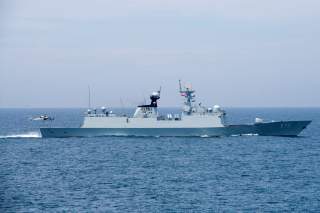650 Warships and Counting: Here's How Large China's Navy Is
That's a whole lot of boats.
Key Point: It looks like America needs to build more ships and get its allies to step up their games. Otherwise, Beijing may well dominate the Western Pacific.The Chinese fleet is much bigger than most people think. And that should compel the United States to reconsider its Pacific maritime strategy, one expert argued.
The People's Liberation Army Navy possesses between 313 and 342 warships, the U.S. Office of Naval Intelligence estimated.
By comparison, in mid-2018 the U.S. Navy possessed 285 warships.
But the PLAN accounts for only a fraction of China's maritime power, according to Andrew Erickson, a professor at the U.S. Naval War College.
"China’s armed forces comprise three major organizations, each with a maritime subcomponent that is already the world’s largest such sea force by number of ships," Erickson wrote in Indo-Pacific Defense Forum.
Beside the PLAN, Beijing's maritime organizations include the Chinese Coast Guard and the People’s Armed Forces Maritime Militia, or PAFMM.
The coast guard and maritime militia help the Chinese Communist Party to pursue its foreign policy goals. "Not seeking war but determined to change the status quo coercively, Beijing employs its enormous second and third sea forces in so-called maritime gray zone operations to further its disputed sovereignty claims in the near seas (Yellow, East and South China seas)," Erickson wrote.
The coast guard and militia have grown alongside the PLAN, Erickson revealed. "China’s second sea force, the coast guard, is ... the world’s largest, with more hulls than those of all its regional neighbors combined: 225 ships over 500 tons capable of operating offshore and another 1,050-plus confined to closer waters, for a total of 1,275."
New coast guard ships are much more sophisticated than the vessels they're replacing. "In terms of qualitative improvement, China has now replaced its older, less-capable large patrol ships," Erickson wrote. "It is applying lessons learned from scrutinizing the 'gold standard' U.S. and Japanese coast guards, as well as the CCG’s increasing experience operating farther offshore for longer periods. The resulting new ship features include helicopters, interceptor boats, deck guns, high-capacity water cannons and improved seakeeping."
The maritime militia likewise has grown and modernized. "Since 2015, starting in Sansha City in the Paracels, China has been developing a full-time militia force: more professional, militarized, well-paid units including military recruits, crewing 84 large vessels built with water cannons and external rails for spraying and ramming," Erickson explained.
"Lacking fishing responsibilities, personnel train for manifold peacetime and wartime contingencies, including with light arms, and deploy regularly to disputed South China Sea features even during fishing moratoriums."
Combined, the PLAN, coast guard and militia possess around 650 large vessels with military capabilities. But China isn't the only country to oversee several maritime forces. The United States too possesses a quasi-military, oceangoing coast guard and the civilian-operated Military Sealfift Command.
The U.S. Coast Guard operates around 240 cutters greater than 65 feet in length. MSC operates 120 logistics, cargo and support ships. Add them to the Navy's 285 warships and you get a combined U.S. fleet numbering 645 ships with military capability.
In other words, the U.S. and Chinese fleets are roughly the same size, in terms of hulls. On average, American ships are bigger and more sophisticated, but as Erickson explained, "numbers matter significantly when it comes to maintaining presence and influence in vital seas."
"Even the most advanced ship simply cannot be in more than one place simultaneously," Erickson wrote.
Moreover, U.S. interests are global while China's are regional. "U.S. Coast Guard cutters are focused near American waters, far from any international disputes, while the U.S. Navy is dispersed globally, with many ships separated from maritime East Asia by responsibilities, geography and time. By contrast, all three major Chinese sea forces remain focused first and foremost on the contested near seas and their immediate approaches, close to China’s homeland, land-based air and missile coverage and supply lines."
America's allies contribute their own forces to international efforts to manage China's rise as a military power. But that doesn't mean the United States shouldn't reconsider its own strategy in light of China's numerical advantage at sea.
"The U.S. should further demonstrate proactive leadership in the Indo-Pacific by sharing more information on all three [Chinese] sea forces, emphasizing the cooperative nature of collective security and encouraging allies and partners to invest in capabilities that complement those of the U.S.," Erickson advised.
David Axe serves as the Defense Editor of the National Interest. He is the author of the graphic novels War Fix, War Is Boring and Machete Squad. This first appeared in 2019 and is being reposted due to reader interest.
Image: Reuters

